Contents
| An application example converting from one color model to another.
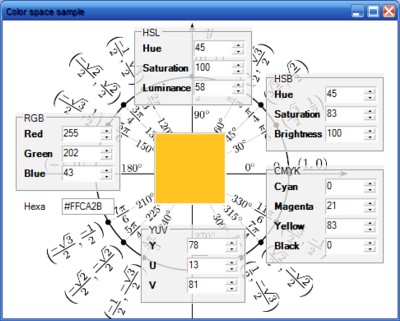
|
Why an article on "colors"? It's the same question I asked myself before writing this series.
The fact is, in .NET, there are only two color formats that can be used: the RGB color model and the HSB color model. Those two are encapsulated in the Color structure of the System.Drawing namespace.
It is largely sufficient for simple uses, like changing the background color of a component, but insufficient if we want to develop graphic tools (or something which implies conversion between color formats).
I've started looking for other formats, like CMYK, when I was learning how to add cool design-time support to my custom controls.
But, I quickly understood the utilities I was coding would be more than useful in other projects, like my SVG editor.
That's why I publish this series of 3 articles. The proposed article content will be as follows:
- Part 1: This one, will be an introduction into color spaces, and the most used ones.
- Part 2: Will be about dedicated controls, or how to select/define a color with custom components. I will share a lot of my custom controls for this purpose.
- Part 3: Will be about how to use those color controls at design-time. It will be a tutorial on how to create your own editors.
Let's start with some definitions
"Color (or colour, see spelling differences) is the visual perceptual property corresponding in humans to the categories called red, yellow, white, etc. Color derives from the spectrum of light (distribution of light energy versus wavelength) interacting in the eye with the spectral sensitivities of the light receptors. Color categories and physical specifications of color are also associated with objects, materials, light sources, etc., based on their physical properties such as light absorption, reflection, or emission spectra."
Color definition, Wikipedia.
"Colorimetry is the science that describes colors in numbers, or provides a physical color match using a variety of measurement instruments. Colorimetry is used in chemistry, and in industries such as color printing, textile manufacturing, paint manufacturing and in the food industry."
Colorimetry definition, Wikipedia.
Then, how can we display colors as numbers? the answer: color models.
I - Color models
A - RGB (Red Green Blue)
The RGB (Red, Green, Blue) color model is the most known, and the most used every day. It defines a color space in terms of three components:
- Red, which ranges from 0-255
- Green, which ranges from 0-255
- Blue, which ranges from 0-255
The RGB color model is an additive one. In other words, Red, Green and Blue values (known as the three primary colors) are combined to reproduce other colors.
For example, the color "Red" can be represented as [R=255, G=0, B=0], "Violet" as [R=238, G=130, B=238], etc.
Its common graphic representation is the following image:

In .NET, the Color structure use this model to provide color support through R, G and B properties.
Console.WriteLine(String.Format("R={0}, G={1}, B={2}",
Color.Red.R, Color.Red.G, Color.Red.B);
Console.WriteLine(String.Format("R={0}, G={1}, B={2}",
Color.Cyan.R, Color.Cyan.G, Color.Cyan.B);
Console.WriteLine(String.Format("R={0}, G={1}, B={2}",
Color.White.R, Color.White.G, Color.White.B);
Console.WriteLine(String.Format("R={0}, G={1}, B={2}",
Color.SteelBlue.R, Color.SteelBlue.G, Color.SteelBlue.B);
but this is not its only usage. For this reason, we can define a dedicated RGB structure for further coding, as shown below:
public struct RGB
{
public static readonly RGB Empty = new RGB();
private int red;
private int green;
private int blue;
public static bool operator ==(RGB item1, RGB item2)
{
return (
item1.Red == item2.Red
&& item1.Green == item2.Green
&& item1.Blue == item2.Blue
);
}
public static bool operator !=(RGB item1, RGB item2)
{
return (
item1.Red != item2.Red
|| item1.Green != item2.Green
|| item1.Blue != item2.Blue
);
}
public int Red
{
get
{
return red;
}
set
{
red = (value>255)? 255 : ((value<0)?0 : value);
}
}
public int Green
{
get
{
return green;
}
set
{
green = (value>255)? 255 : ((value<0)?0 : value);
}
}
public int Blue
{
get
{
return blue;
}
set
{
blue = (value>255)? 255 : ((value<0)?0 : value);
}
}
public RGB(int R, int G, int B)
{
this.red = (R>255)? 255 : ((R<0)?0 : R);
this.green = (G>255)? 255 : ((G<0)?0 : G);
this.blue = (B>255)? 255 : ((B<0)?0 : B);
}
public override bool Equals(Object obj)
{
if(obj==null || GetType()!=obj.GetType()) return false;
return (this == (RGB)obj);
}
public override int GetHashCode()
{
return Red.GetHashCode() ^ Green.GetHashCode() ^ Blue.GetHashCode();
}
}
B - HSB color space
The HSB (Hue, Saturation, Brightness) color model defines a color space in terms of three constituent components:
- Hue : the color type (such as red, blue, or yellow).
- Ranges from 0 to 360° in most applications. (each value corresponds to one color : 0 is red, 45 is a shade of orange and 55 is a shade of yellow).
- Saturation : the intensity of the color.
- Ranges from 0 to 100% (0 means no color, that is a shade of grey between black and white; 100 means intense color).
- Also sometimes called the "purity" by analogy to the colorimetric quantities excitation purity.
- Brightness (or Value) : the brightness of the color.
- Ranges from 0 to 100% (0 is always black; depending on the saturation, 100 may be white or a more or less saturated color).
Its common graphic representation is the following image:
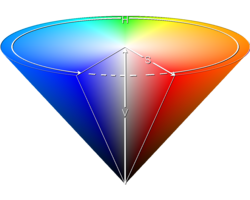
The HSB model is also known as HSV (Hue, Saturation, Value) model. The HSV model was created in 1978 by Alvy Ray Smith. It is a nonlinear transformation of the RGB color space. In other words, color is not defined as a simple combination (addition/substraction) of primary colors but as a mathematical transformation.
Note: HSV and HSB are the same, but HSL is different.
All this said, a HSB structure can be :
public struct HSB
{
public static readonly HSB Empty = new HSB();
private double hue;
private double saturation;
private double brightness;
public static bool operator ==(HSB item1, HSB item2)
{
return (
item1.Hue == item2.Hue
&& item1.Saturation == item2.Saturation
&& item1.Brightness == item2.Brightness
);
}
public static bool operator !=(HSB item1, HSB item2)
{
return (
item1.Hue != item2.Hue
|| item1.Saturation != item2.Saturation
|| item1.Brightness != item2.Brightness
);
}
public double Hue
{
get
{
return hue;
}
set
{
hue = (value>360)? 360 : ((value<0)?0:value);
}
}
public double Saturation
{
get
{
return saturation;
}
set
{
saturation = (value>1)? 1 : ((value<0)?0:value);
}
}
public double Brightness
{
get
{
return brightness;
}
set
{
brightness = (value>1)? 1 : ((value<0)? 0 : value);
}
}
public HSB(double h, double s, double b)
{
hue = (h>360)? 360 : ((h<0)?0:h);
saturation = (s>1)? 1 : ((s<0)?0:s);
brightness = (b>1)? 1 : ((b<0)?0:b);
}
public override bool Equals(Object obj)
{
if(obj==null || GetType()!=obj.GetType()) return false;
return (this == (HSB)obj);
}
public override int GetHashCode()
{
return Hue.GetHashCode() ^ Saturation.GetHashCode() ^
Brightness.GetHashCode();
}
}
C - HSL color space
The HSL color space, also called HLS or HSI, stands for:
- Hue : the color type (such as red, blue, or yellow).
- Ranges from 0 to 360° in most applications (each value corresponds to one color : 0 is red, 45 is a shade of orange and 55 is a shade of yellow).
- Saturation : variation of the color depending on the lightness.
- Ranges from 0 to 100% (from the center of the black&white axis).
- Lightness (also Luminance or Luminosity or Intensity).
- Ranges from 0 to 100% (from black to white).
Its common graphic representation is the following image:
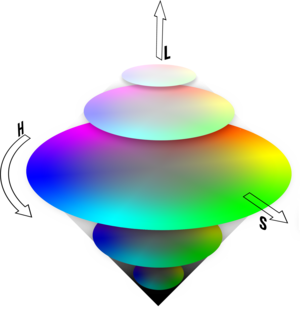
HSL is similar to HSB. The main difference is that HSL is symmetrical to lightness and darkness. This means that:
- In HSL, the Saturation component always goes from fully saturated color to the equivalent gray (in HSB, with B at maximum, it goes from saturated color to white).
- In HSL, the Lightness always spans the entire range from black through the chosen hue to white (in HSB, the B component only goes half that way, from black to the chosen hue).
For my part, HSL offers a more accurate (even if it's not absolute) color approximation than HSB.
All this said, a HSL structure can be:
public struct HSL
{
public static readonly HSL Empty = new HSL();
private double hue;
private double saturation;
private double luminance;
public static bool operator ==(HSL item1, HSL item2)
{
return (
item1.Hue == item2.Hue
&& item1.Saturation == item2.Saturation
&& item1.Luminance == item2.Luminance
);
}
public static bool operator !=(HSL item1, HSL item2)
{
return (
item1.Hue != item2.Hue
|| item1.Saturation != item2.Saturation
|| item1.Luminance != item2.Luminance
);
}
public double Hue
{
get
{
return hue;
}
set
{
hue = (value>360)? 360 : ((value<0)?0:value);
}
}
public double Saturation
{
get
{
return saturation;
}
set
{
saturation = (value>1)? 1 : ((value<0)?0:value);
}
}
public double Luminance
{
get
{
return luminance;
}
set
{
luminance = (value>1)? 1 : ((value<0)? 0 : value);
}
}
public HSL(double h, double s, double l)
{
this.hue = (h>360)? 360 : ((h<0)?0:h);
this.saturation = (s>1)? 1 : ((s<0)?0:s);
this.luminance = (l>1)? 1 : ((l<0)?0:l);
}
public override bool Equals(Object obj)
{
if(obj==null || GetType()!=obj.GetType()) return false;
return (this == (HSL)obj);
}
public override int GetHashCode()
{
return Hue.GetHashCode() ^ Saturation.GetHashCode() ^
Luminance.GetHashCode();
}
}
D - CMYK color space
The CMYK color space, also known as CMJN, stands for:
- Cyan.
- Ranges from 0 to 100% in most applications.
- Magenta.
- Ranges from 0 to 100% in most applications.
- Yellow.
- Ranges from 0 to 100% in most applications.
- blacK.
- Ranges from 0 to 100% in most applications.
It is a subtractive color model used in color printing. CMYK works on an optical illusion that is based on light absorption.
The principle is to superimpose three images; one for cyan, one for magenta and one for yellow; which will reproduce colors.
Its common graphic representation is the following image:

Like the RGB color model, CMYK is a combination of primary colors (cyan, magenta, yellow and black). It is, probably, the only thing they have in common.
CMYK suffers from a lack of color shades that causes holes in the color spectrum it can reproduce. That's why there are often differencies when someone convert a color between CMYK to RGB.
Why using this model? Why black is used? you can tell me... Well it's only for practical purpose. Wikipedia said:
- To improve print quality and reduce moiré patterns,
- Text is typically printed in black and includes fine detail (such as serifs); so to reproduce text using three inks would require an extremely precise alignment for each three components image.
- A combination of cyan, magenta, and yellow pigments don't produce (or rarely) pure black.
- Mixing all three color inks together to make black can make the paper rather wet when not using dry toner, which is an issue in high speed printing where the paper must dry extremely rapidly to avoid marking the next sheet, and poor quality paper such as newsprint may break if it becomes too wet.
- Using a unit amount of black ink rather than three unit amounts of the process color inks can lead to significant cost savings (black ink is often cheaper).
Let's come back to our reality. A CMYK structure can be:
public struct CMYK
{
public readonly static CMYK Empty = new CMYK();
private double c;
private double m;
private double y;
private double k;
public static bool operator ==(CMYK item1, CMYK item2)
{
return (
item1.Cyan == item2.Cyan
&& item1.Magenta == item2.Magenta
&& item1.Yellow == item2.Yellow
&& item1.Black == item2.Black
);
}
public static bool operator !=(CMYK item1, CMYK item2)
{
return (
item1.Cyan != item2.Cyan
|| item1.Magenta != item2.Magenta
|| item1.Yellow != item2.Yellow
|| item1.Black != item2.Black
);
}
public double Cyan
{
get
{
return c;
}
set
{
c = value;
c = (c>1)? 1 : ((c<0)? 0 : c);
}
}
public double Magenta
{
get
{
return m;
}
set
{
m = value;
m = (m>1)? 1 : ((m<0)? 0 : m);
}
}
public double Yellow
{
get
{
return y;
}
set
{
y = value;
y = (y>1)? 1 : ((y<0)? 0 : y);
}
}
public double Black
{
get
{
return k;
}
set
{
k = value;
k = (k>1)? 1 : ((k<0)? 0 : k);
}
}
public CMYK(double c, double m, double y, double k)
{
this.c = c;
this.m = m;
this.y = y;
this.k = k;
}
public override bool Equals(Object obj)
{
if(obj==null || GetType()!=obj.GetType()) return false;
return (this == (CMYK)obj);
}
public override int GetHashCode()
{
return Cyan.GetHashCode() ^
Magenta.GetHashCode() ^ Yellow.GetHashCode() ^ Black.GetHashCode();
}
}
E - YUV color space
The YUV model defines a color space in terms of one luma and two chrominance components. The YUV color model is used in the PAL, NTSC, and SECAM composite color video standards.
YUV models human perception of color more closely than the standard RGB model used in computer graphics hardware.
The YUV color space stands for:
- Y, the luma component, or the brightness.
- Ranges from 0 to 100% in most applications.
- U and V are the chrominance components (blue-luminance and red-luminance differences components).
- Expressed as factors depending on the YUV version you want to use.
A graphic representation is the following image:
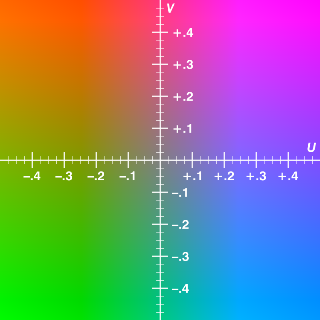
A YUV structure can be:
public struct YUV
{
public static readonly YUV Empty = new YUV();
private double y;
private double u;
private double v;
public static bool operator ==(YUV item1, YUV item2)
{
return (
item1.Y == item2.Y
&& item1.U == item2.U
&& item1.V == item2.V
);
}
public static bool operator !=(YUV item1, YUV item2)
{
return (
item1.Y != item2.Y
|| item1.U != item2.U
|| item1.V != item2.V
);
}
public double Y
{
get
{
return y;
}
set
{
y = value;
y = (y>1)? 1 : ((y<0)? 0 : y);
}
}
public double U
{
get
{
return u;
}
set
{
u = value;
u = (u>0.436)? 0.436 : ((u<-0.436)? -0.436 : u);
}
}
public double V
{
get
{
return v;
}
set
{
v = value;
v = (v>0.615)? 0.615 : ((v<-0.615)? -0.615 : v);
}
}
public YUV(double y, double u, double v)
{
this.y = (y>1)? 1 : ((y<0)? 0 : y);
this.u = (u>0.436)? 0.436 : ((u<-0.436)? -0.436 : u);
this.v = (v>0.615)? 0.615 : ((v<-0.615)? -0.615 : v);
}
public override bool Equals(Object obj)
{
if(obj==null || GetType()!=obj.GetType()) return false;
return (this == (YUV)obj);
}
public override int GetHashCode()
{
return Y.GetHashCode() ^ U.GetHashCode() ^ V.GetHashCode();
}
}
F - CIE XYZ color space
In opposition to the previous models, the CIE XYZ model defines an absolute color space. It is also known as the CIE 1931 XYZ color space and stands for:
- X, which can be compared to red
- Y, which can be compared to green
- Z, which can be compared to blue
Before trying to explain why I include this color space in this article, you have to know that it's one of the first standards created by the International Commission on Illumination (CIE) in 1931. It is based on direct measurements of the human eye, and serves as the basis from which many other color spaces are defined.
A graphic representation is the following image:
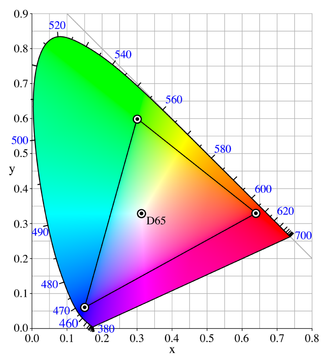
A CIE XYZ structure can be:
public struct CIEXYZ
{
public static readonly CIEXYZ Empty = new CIEXYZ();
public static readonly CIEXYZ D65 = new CIEXYZ(0.9505, 1.0, 1.0890);
private double x;
private double y;
private double z;
public static bool operator ==(CIEXYZ item1, CIEXYZ item2)
{
return (
item1.X == item2.X
&& item1.Y == item2.Y
&& item1.Z == item2.Z
);
}
public static bool operator !=(CIEXYZ item1, CIEXYZ item2)
{
return (
item1.X != item2.X
|| item1.Y != item2.Y
|| item1.Z != item2.Z
);
}
public double X
{
get
{
return this.x;
}
set
{
this.x = (value>0.9505)? 0.9505 : ((value<0)? 0 : value);
}
}
public double Y
{
get
{
return this.y;
}
set
{
this.y = (value>1.0)? 1.0 : ((value<0)?0 : value);
}
}
public double Z
{
get
{
return this.z;
}
set
{
this.z = (value>1.089)? 1.089 : ((value<0)? 0 : value);
}
}
public CIEXYZ(double x, double y, double z)
{
this.x = (x>0.9505)? 0.9505 : ((x<0)? 0 : x);
this.y = (y>1.0)? 1.0 : ((y<0)? 0 : y);
this.z = (z>1.089)? 1.089 : ((z<0)? 0 : z);
}
public override bool Equals(Object obj)
{
if(obj==null || GetType()!=obj.GetType()) return false;
return (this == (CIEXYZ)obj);
}
public override int GetHashCode()
{
return X.GetHashCode() ^ Y.GetHashCode() ^ Z.GetHashCode();
}
}
Well! why do I have to include this model?
I have made a quick research to include Cie L*a*b* color model in this article, and I find that a conversion to an absolute color space is required before converting to L*a*b*. The model used in the conversion principle is Cie XYZ. So, I've included it and now everyone can understand "what are those XYZ values" used further in the article.
G - CIE L*a*b* color space
"A Lab color space is a color-opponent space with dimension L for luminance and a and b for the color-opponent dimensions, based on nonlinearly-compressed CIE XYZ color space coordinates."
As said in the previous definition, CIE L*a*b* color space, also know as CIE 1976 color space, stands for:
- L*, the luminance
- a*, the red/green color-opponent dimension
- b*, the yellow/blue color-opponent dimension
The L*a*b* color model has been created to serve as a device independent model to be used as a reference. It is based directly on the CIE 1931 XYZ color space as an attempt to linearize the perceptibility of color differences.
The non-linear relations for L*, a*, and b* are intended to mimic the logarithmic response of the eye, coloring information is referred to the color of the white point of the system.
A CIE L*a*b* structure can be:
public struct CIELab
{
public static readonly CIELab Empty = new CIELab();
private double l;
private double a;
private double b;
public static bool operator ==(CIELab item1, CIELab item2)
{
return (
item1.L == item2.L
&& item1.A == item2.A
&& item1.B == item2.B
);
}
public static bool operator !=(CIELab item1, CIELab item2)
{
return (
item1.L != item2.L
|| item1.A != item2.A
|| item1.B != item2.B
);
}
public double L
{
get
{
return this.l;
}
set
{
this.l = value;
}
}
public double A
{
get
{
return this.a;
}
set
{
this.a = value;
}
}
public double B
{
get
{
return this.b;
}
set
{
this.b = value;
}
}
public CIELab(double l, double a, double b)
{
this.l = l;
this.a = a;
this.b = b;
}
public override bool Equals(Object obj)
{
if(obj==null || GetType()!=obj.GetType()) return false;
return (this == (CIELab)obj);
}
public override int GetHashCode()
{
return L.GetHashCode() ^ a.GetHashCode() ^ b.GetHashCode();
}
}
There are still many other formats like RYB and CcMmYK. I still don't intend to create a "color framework", but if you have other ideas...
II - Conversion between models
A - RGB conversions
Converting RGB color to any other model is the basis in conversion algorithms. It implies a normalisation of red, green and blue : value ranges now from [0..255] to [0..1].
a - RGB to HSB
The conversion principle is the one below:
H ? [0, 360]
S, V, R, G, B ? [0, 1]
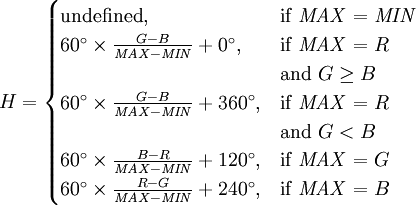

V = MAX
Well! Interesting! But what's the C# equivalent? Here it is.
public static HSB RGBtoHSB(int red, int green, int blue)
{
double r = ((double)red/255.0);
double g = ((double)green/255.0);
double b = ((double)blue/255.0);
double max = Math.Max(r, Math.Max(g, b));
double min = Math.Min(r, Math.Min(g, b));
double h = 0.0;
if(max==r && g>=b)
{
h = 60 * (g-b)/(max-min);
}
else if(max==r && g < b)
{
h = 60 * (g-b)/(max-min) + 360;
}
else if(max == g)
{
h = 60 * (b-r)/(max-min) + 120;
}
else if(max == b)
{
h = 60 * (r-g)/(max-min) + 240;
}
double s = (max == 0)? 0.0 : (1.0 - (min/max));
return new HSB(h, s, (double)max);
}
b - RGB to HSL
The conversion principle is the one below:
H ? [0, 360]
S, L, R, G, B ? [0, 1]
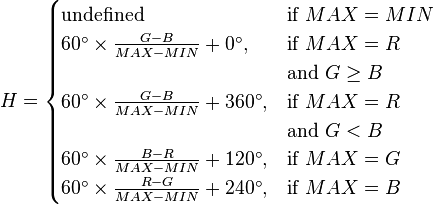

L = ½(MAX + MIN)
The C# equivalent is:
public static HSL RGBtoHSL(int red, int green, int blue)
{
double h=0, s=0, l=0;
double r = (double)red/255.0;
double g = (double)green/255.0;
double b = (double)blue/255.0;
double max = Math.Max(r, Math.Max(g, b));
double min = Math.Min(r, Math.Min(g, b));
if(max == min)
{
h = 0;
}
else if(max==r && g>=b)
{
h = 60.0*(g-b)/(max-min);
}
else if(max==r && g<b)
{
h = 60.0*(g-b)/(max-min) + 360.0;
}
else if(max==g)
{
h = 60.0*(b-r)/(max-min) + 120.0;
}
else if(max==b)
{
h = 60.0*(r-g)/(max-min) + 240.0;
}
l = (max+min)/2.0;
if(l == 0 || max == min)
{
s = 0;
}
else if(0<l && l<=0.5)
{
s = (max-min)/(max+min);
}
else if(l>0.5)
{
s = (max-min)/(2 - (max+min));
}
return new HSL(
Double.Parse(String.Format("{0:0.##}", h)),
Double.Parse(String.Format("{0:0.##}", s)),
Double.Parse(String.Format("{0:0.##}", l))
);
}
Note: You have probably noticed String.Format("{0:0.##}", h)... It's the .NET solution for keeping the same rounding behavior. If you don't understand what I mean, try the sample code below:
Console.WriteLine(Math.Round(4.45, 1));
Console.WriteLine(Math.Round(4.55, 1));
You didn't notice a problem? Ok, rouding 4.45 should have returned 4.5 and not 4.4. The solution is using String.Format() which always applies "round-to-even" method.
c - RGB to CMYK
The conversion principle is the one below :
R, G, B ? [0, 1]
tC'M'Y' = {1 - R, 1 - G, 1 - B}
K = min{C', M', Y'}
tCMYK = {0, 0, 0, 1} if K = 1
tCMYK = { (C' - K)/(1 - K), (M' - K)/(1 - K), (Y' - K)/(1 - K), K } otherwise
The C# equivalent is:
public static CMYK RGBtoCMYK(int red, int green, int blue)
{
double c = (double)(255 - red)/255;
double m = (double)(255 - green)/255;
double y = (double)(255 - blue)/255;
double k = (double)Math.Min(c, Math.Min(m, y));
if(k == 1.0)
{
return new CMYK(0,0,0,1);
}
else
{
return new CMYK((c-k)/(1-k), (m-k)/(1-k), (y-k)/(1-k), k);
}
}
d - RGB to YUV (YUV444)
The conversion principle is the one below :
R, G, B, Y ? [0, 1]
U ? [-0.436, 0.436]
V ? [-0.615, 0.615]
tYUV = { (0.299 R + 0.587 G + 0.114 B), (- 0.14713 R + 0.28886 G + 0.436 B), (0.615 R + 0.51499 G + 0.10001 B) }
The C# equivalent is :
public static YUV RGBtoYUV(int red, int green, int blue)
{
YUV yuv = new YUV();
double r = (double)red/255.0;
double g = (double)green/255.0;
double b = (double)blue/255.0;
yuv.Y = 0.299*r + 0.587*g + 0.114*b;
yuv.U = -0.14713*r -0.28886*g + 0.436*b;
yuv.V = 0.615*r -0.51499*g -0.10001*b;
return yuv;
}
e - RGB to web color
Haaa! Something I can explain.
As you probably already know, web colors can be defined in two ways: for example, "red" can be defined as rgb(255,0,0) or #FF0000.
The explanation of the second form is simple :
- "
#" character tells that the format is the hexadecimal one. - The last 6 characters define 3 pairs: one for "Red", one for "Green" and one for "Blue".
- Each pair is a hexadecimal value (base 16) of a value which ranges from 0 to 255.
So, you can divide each color component by 16 and replace numbers superior to 9 by theirs hexadecimal value (eg. 10 = A, 11 = B, etc.)... but the best way is to use String.Format() habilities.
public static string RGBToHex(int r, int g, int b)
{
return String.Format("#{0:x2}{1:x2}{2:x2}", r, g, b).ToUpper();
}
f - RGB to XYZ
The conversion principle is the one below:
R, G, B ? [0, 1]
a = 0.055 and ? ˜ 2.2

where

The C# equivalent is :
public static CIEXYZ RGBtoXYZ(int red, int green, int blue)
{
double rLinear = (double)red/255.0;
double gLinear = (double)green/255.0;
double bLinear = (double)blue/255.0;
double r = (rLinear > 0.04045)? Math.Pow((rLinear + 0.055)/(
1 + 0.055), 2.2) : (rLinear/12.92) ;
double g = (gLinear > 0.04045)? Math.Pow((gLinear + 0.055)/(
1 + 0.055), 2.2) : (gLinear/12.92) ;
double b = (bLinear > 0.04045)? Math.Pow((bLinear + 0.055)/(
1 + 0.055), 2.2) : (bLinear/12.92) ;
return new CIEXYZ(
(r*0.4124 + g*0.3576 + b*0.1805),
(r*0.2126 + g*0.7152 + b*0.0722),
(r*0.0193 + g*0.1192 + b*0.9505)
);
}
g - RGB to L*a*b*
As I said before, converting to the CIE L*a*b color model is a little bit tricky: we need to convert to CIE XYZ before trying to have L*a*b* values.
public static CIELab RGBtoLab(int red, int green, int blue)
{
return XYZtoLab( RGBtoXYZ(red, green, blue) );
}
The conversion between XYZ and L*a*b* is given below.
B - HSB conversions
a - HSB to RGB
The conversion principle is the one below :
H ? [0, 360]
S, V, R, G, B ? [0, 1]
Hi = [H / 60] mod 6
f = (H / 60) - Hi
p = V (1 - S)
q = V (1 - f S)
t = V (1 - (1 - f ) S)
if Hi = 0 ? R = V, G = t, B = p
if Hi = 1 ? R = q, G = V, B = p
if Hi = 2 ? R = p, G = V, B = t
if Hi = 3 ? R = p, G = q, B = V
if Hi = 4 ? R = t, G = p, B = V
if Hi = 5 ? R = V, G = p, B = q
The C# equivalent? Here it is.
public static RGB HSBtoRGB(double h, double s, double b)
{
double r = 0;
double g = 0;
double b = 0;
if(s == 0)
{
r = g = b = b;
}
else
{
double sectorPos = h / 60.0;
int sectorNumber = (int)(Math.Floor(sectorPos));
double fractionalSector = sectorPos - sectorNumber;
double p = b * (1.0 - s);
double q = b * (1.0 - (s * fractionalSector));
double t = b * (1.0 - (s * (1 - fractionalSector)));
switch(sectorNumber)
{
case 0:
r = b;
g = t;
b = p;
break;
case 1:
r = q;
g = b;
b = p;
break;
case 2:
r = p;
g = b;
b = t;
break;
case 3:
r = p;
g = q;
b = b;
break;
case 4:
r = t;
g = p;
b = b;
break;
case 5:
r = b;
g = p;
b = q;
break;
}
}
return new RGB(
Convert.ToInt32( Double.Parse(String.Format("{0:0.00}", r*255.0)) ),
Convert.ToInt32( Double.Parse(String.Format("{0:0.00}", g*255.0)) ),
Convert.ToInt32( Double.Parse(String.Format("{0:0.00}", b*255.0)) )
);
}
b - HSB to HSL
Conversion principle is quite simple (but not accurate): convert to RGB and then to HSL.
public static HSL HSBtoHSL(double h, double s, double b)
{
RGB rgb = HSBtoRGB(h, s, b);
return RGBtoHSL(rgb.Red, rgb.Green, rgb.Blue);
}
c - HSB to CMYK
Nothing new : conversion principle is to convert to RGB and then to CMYK.
public static CMYK HSBtoCMYK(double h, double s, double b)
{
RGB rgb = HSBtoRGB(h, s, b);
return RGBtoCMYK(rgb.Red, rgb.Green, rgb.Blue);
}
d - HSB to YUV
Nothing new : conversion principle is to convert to RGB and then to YUV.
public static YUV HSBtoYUV(double h, double s, double b)
{
RGB rgb = HSBtoRGB(h, s, b);
return RGBtoYUV(rgb.Red, rgb.Green, rgb.Blue);
}
C - HSL conversions
a - HSL to RGB
The conversion principle is the one below :
H ? [0, 360]
S, L, R, G, B ? [0, 1]
if L < 0.5 ? Q = L × (1 + S)
if L = 0.5 ? Q = L + S – (L × S)
P = 2 × L – Q
Hk = H / 360
Tr = Hk + 1/3
Tg = Hk
Tb = Hk – 1/3
For each c = R,G,B :
if Tc < 0 ? Tc = Tc + 1.0
if Tc > 1 ? Tc = Tc – 1.0
if Tc < 1/6 ? Tc = P + ((Q – P) × 6.0 × Tc)
if 1/6 = Tc > 1/2 ? Tc = Q
if 1/2 = Tc > 2/3 ? Tc = P + ((Q – P) × (2/3 – Tc) × 6.0)
else Tc = P
The C# equivalent? Here it is.
public static RGB HSLtoRGB(double h, double s, double l)
{
if(s == 0)
{
return new RGB(
Convert.ToInt32( Double.Parse(String.Format("{0:0.00}",
l*255.0)) ),
Convert.ToInt32( Double.Parse(String.Format("{0:0.00}",
l*255.0)) ),
Convert.ToInt32( Double.Parse(String.Format("{0:0.00}",
l*255.0)) )
);
}
else
{
double q = (l<0.5)?(l * (1.0+s)):(l+s - (l*s));
double p = (2.0 * l) - q;
double Hk = h/360.0;
double[] T = new double[3];
T[0] = Hk + (1.0/3.0);
T[1] = Hk;
T[2] = Hk - (1.0/3.0);
for(int i=0; i<3; i++)
{
if(T[i] < 0) T[i] += 1.0;
if(T[i] > 1) T[i] -= 1.0;
if((T[i]*6) < 1)
{
T[i] = p + ((q-p)*6.0*T[i]);
}
else if((T[i]*2.0) < 1)
{
T[i] = q;
}
else if((T[i]*3.0) < 2)
{
T[i] = p + (q-p) * ((2.0/3.0) - T[i]) * 6.0;
}
else T[i] = p;
}
return new RGB(
Convert.ToInt32( Double.Parse(String.Format("{0:0.00}",
T[0]*255.0)) ),
Convert.ToInt32( Double.Parse(String.Format("{0:0.00}",
T[1]*255.0)) ),
Convert.ToInt32( Double.Parse(String.Format("{0:0.00}",
T[2]*255.0)) )
);
}
}
b - HSL to HSB
Nothing new: conversion principle is to convert to RGB and then to HSB.
public static HSB HSLtoHSB(double h, double s, double l)
{
RGB rgb = HSLtoRGB(h, s, l);
return RGBtoHSB(rgb.Red, rgb.Green, rgb.Blue);
}
c - HSL to CMYK
Nothing new: conversion principle is to convert to RGB and then to CMYK.
public static CMYK HSLtoCMYK(double h, double s, double l)
{
RGB rgb = HSLtoRGB(h, s, l);
return RGBtoCMYK(rgb.Red, rgb.Green, rgb.Blue);
}
d - HSL to YUV
Nothing new: conversion principle is to convert to RGB and then to CMYK.
public static YUV HSLtoYUV(double h, double s, double l)
{
RGB rgb = HSLtoRGB(h, s, l);
return RGBtoYUV(rgb.Red, rgb.Green, rgb.Blue);
}
D - CMYK conversions
a - CMYK to RGB
The conversion principle is the one below:
tRGB = { (1 - C) × (1 - K) , (1 - M) × (1 - K), (1 - Y) × (1 - K)}
The C# equivalent? Here it is.
public static Color CMYKtoRGB(double c, double m, double y, double k)
{
int red = Convert.ToInt32((1-c) * (1-k) * 255.0);
int green = Convert.ToInt32((1-m) * (1-k) * 255.0);
int blue = Convert.ToInt32((1-y) * (1-k) * 255.0);
return Color.FromArgb(red, green, blue);
}
b - CMYK to HSL
Nothing new: conversion principle is to convert to RGB and then to HSL.
public static HSL CMYKtoHSL(double c, double m, double y, double k)
{
RGB rgb = CMYKtoRGB(c, m, y, k);
return RGBtoHSL(rgb.Red, rgb.Green, rgb.Blue);
}
c - CMYK to HSB
Nothing new: conversion principle is to convert to RGB and then to HSB.
public static HSB CMYKtoHSB(double c, double m, double y, double k)
{
RGB rgb = CMYKtoRGB(c, m, y, k);
return RGBtoHSB(rgb.Red, rgb.Green, rgb.Blue);
}
d - CMYK to YUV
Nothing new: conversion principle is to convert to RGB and then to YUV.
public static YUV CMYKtoYUV(double c, double m, double y, double k)
{
RGB rgb = CMYKtoRGB(c, m, y, k);
return RGBtoYUV(rgb.Red, rgb.Green, rgb.Blue);
}
E - YUV conversions
a - YUV to RGB
The conversion principle is the one below:
R, G, B, Y ? [0, 1]
U ? [-0.436, 0.436]
V ? [-0.615, 0.615]
tRGB = { (Y + 1.13983 V), (Y - 0.39466 U - 0.58060 V), (Y + 2.03211 U) }
The C# equivalent is :
public static RGB YUVtoRGB(double y, double u, double v)
{
RGB rgb = new RGB();
rgb.Red = Convert.ToInt32((y + 1.139837398373983740*v)*255);
rgb.Green = Convert.ToInt32((
y - 0.3946517043589703515*u - 0.5805986066674976801*v)*255);
rgb.Blue = Convert.ToInt32((y + 2.032110091743119266*u)*255);
return rgb;
}
b - YUV to HSL
Nothing new: conversion principle is to convert to RGB and then to HSL.
public static HSL YUVtoHSL(double y, double u, double v)
{
RGB rgb = YUVtoRGB(y, u, v);
return RGBtoHSL(rgb.Red, rgb.Green, rgb.Blue);
}
c - YUV to HSB
Nothing new: conversion principle is to convert to RGB and then to HSB.
public static HSB YUVtoHSB(double y, double u, double v)
{
RGB rgb = YUVtoRGB(y, u, v);
return RGBtoHSB(rgb.Red, rgb.Green, rgb.Blue);
}
d - YUV to CMYK
Nothing new: conversion principle is to convert to RGB and then to CMYK.
public static CMYK YUVtoCMYK(double y, double u, double v)
{
RGB rgb = YUVtoRGB(y, u, v);
return RGBtoCMYK(rgb.Red, rgb.Green, rgb.Blue);
}
F - XYZ conversions
a - XYZ to RGB
The conversion principle is the one below:
a = 0.055

then

The C# equivalent is :
public static RGB XYZtoRGB(double x, double y, double z)
{
double[] Clinear = new double[3];
Clinear[0] = x*3.2410 - y*1.5374 - z*0.4986;
Clinear[1] = -x*0.9692 + y*1.8760 - z*0.0416;
Clinear[2] = x*0.0556 - y*0.2040 + z*1.0570;
for(int i=0; i<3; i++)
{
Clinear[i] = (Clinear[i]<=0.0031308)? 12.92*Clinear[i] : (
1+0.055)* Math.Pow(Clinear[i], (1.0/2.4)) - 0.055;
}
return new RGB(
Convert.ToInt32( Double.Parse(String.Format("{0:0.00}",
Clinear[0]*255.0)) ),
Convert.ToInt32( Double.Parse(String.Format("{0:0.00}",
Clinear[1]*255.0)) ),
Convert.ToInt32( Double.Parse(String.Format("{0:0.00}",
Clinear[2]*255.0)) )
);
}
b - XYZ to L*a*b*
The conversion principle is the one below:



where

for
t > 0.008856

otherwise
Xn, Yn and Zn are the CIE XYZ tristimulus values of the reference white point.
The C# equivalent is:
private static double Fxyz(double t)
{
return ((t > 0.008856)? Math.Pow(t, (1.0/3.0)) : (7.787*t + 16.0/116.0));
}
public static CIELab XYZtoLab(double x, double y, double z)
{
CIELab lab = CIELab.Empty;
lab.L = 116.0 * Fxyz( y/CIEXYZ.D65.Y ) -16;
lab.A = 500.0 * (Fxyz( x/CIEXYZ.D65.X ) - Fxyz( y/CIEXYZ.D65.Y) );
lab.B = 200.0 * (Fxyz( y/CIEXYZ.D65.Y ) - Fxyz( z/CIEXYZ.D65.Z) );
return lab;
}
G - L*a*b* conversions
a - L*a*b* to XYZ
The conversion principle is the one below:
d = 6/29



if

then

else

if

then

else

if

then

else

The C# equivalent is:
public static CIEXYZ LabtoXYZ(double l, double a, double b)
{
double delta = 6.0/29.0;
double fy = (l+16)/116.0;
double fx = fy + (a/500.0);
double fz = fy - (b/200.0);
return new CIEXYZ(
(fx > delta)? CIEXYZ.D65.X * (fx*fx*fx) : (fx - 16.0/116.0)*3*(
delta*delta)*CIEXYZ.D65.X,
(fy > delta)? CIEXYZ.D65.Y * (fy*fy*fy) : (fy - 16.0/116.0)*3*(
delta*delta)*CIEXYZ.D65.Y,
(fz > delta)? CIEXYZ.D65.Z * (fz*fz*fz) : (fz - 16.0/116.0)*3*(
delta*delta)*CIEXYZ.D65.Z
);
}
b - L*a*b* to RGB
Nothing really new, the principle is to convert to XYZ and then to RGB :
public static RGB LabtoRGB(double l, double a, double b)
{
return XYZtoRGB( LabtoXYZ(l, a, b) );
}
Using the code
Well, after showing you the conversion algorithms, maybe there is nothing more I can tell you.
In fact, there are many other useful methods in ColorSpaceHelper. You will find:
- Average color implementation (
ColorSpaceHelper.GetColorDistance()). - Wheel color generation (
ColorSpaceHelper.GetWheelColors()) with 32bit support (alpha). - Light spectrum color generation for (
ColorSpaceHelper.GetSpectrumColors()) with 32bit support (alpha). - Conversion to and from web colors (
ColorSpaceHelper.HexToColor()). - Conversion to and from
System.Drawing.Color and the other structures.
Points of Interest
Like I said before, there are many formats. This article gives you an example of how using common color models (RGB, HSL, HSB, etc.) perhaps will help you in your own projects.
Here is a preview of what we can do (and what we will see in the next article) with ColorSpaceHelper:
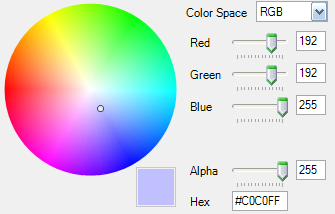
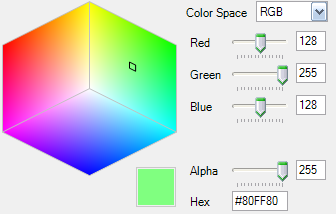
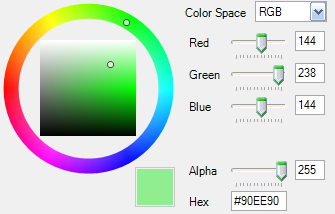
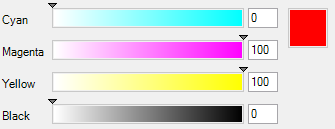

History
- 08 June 2007
- Added GraGra_33 VB .NET version.
- 07 June 2007
- Added CIE XYZ color space definition, and conversion methods in
ColorSpaceHelper. - Added CIE L*a*b* color space definition, and conversion methods in
ColorSpaceHelper.
- 03 June 2007 - Initial article.
